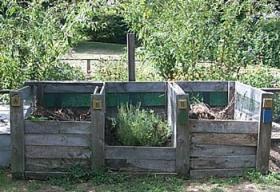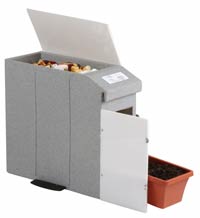Compost Info Guide
Compost Tips, Composting Aritcles, Compost Bin reviews and much more...
Composting Articles:
- How to Compost
- Worm Compost
- 10 Tips for Better Compost
- Fast Compost
- Good Ingredients
- Green Materials
- Brown Materials
- What not to add
- Building a Pile
- Using Compost
- Measuring Moisture
- Compost Maturity
COMPOST BINS
While some people choose to go binless opting for a simple heap on the ground, most of us prefer to use some kind of an enclosure for making our compost.
There are a number of types of containers used to make compost but which type is best?
Well, the answer depends largely on how much space you have in your yard or garden and how much material you will be composting.
In general, the commercially made plastic compost bins are better for beginner composters, while the larger homemade bins are more suited to avid gardeners and those who have a larger volume of materials. But to be honest, that's not really being fair to either the beginner composters or to the seasoned veterans. Let's look more closely at the different types of compost bin as well as some of the advantages and disadvantages of each type.
Plastic Bin:
Due to their generally smaller size, commercially made plastic compost bins tend to be better for those who are not avid gardeners but want to compost some leaves and kitchen scraps. Adding wire mesh to the bottom of the bin ensures that vermin and other local wildlife do not become pests. Look for a model made from 100% recycled plastic.
Advantages of Plastic Compost Bins:
- Locking lid keeps out vermin and local wildlife
- Inexpensive and readily available
Disadvantages of Plastic Compost Bins:
- Challenging to turn the compost through the top opening with a shovel or garden fork -consider using a compost aeration tool for best results
- Lack of air circulation due to solid plastic sides and top
- Removing finished compost from the bottom opening can be awkward
- High temperatures needed to kill pathogens and weed seeds not often reached - plastic compost bins are often too narrow to enable the compost to fully heat up
More info on specific compost bins >> (external website - www.compost-bins.org)
Homemade Compost Bins
Usually, but not always square, these are most often slatted style bins made from wood, or a combination of wood and wire mesh.
Here are some examples:
- Wood posts driven into the ground with wood slats attached to sides
- Wire mesh compost bin with wooden stakes at each of the four corners
- A cylinder of wire mesh attached to two wooden posts driven into the ground
- Shipping pallets set vertically and wired together to make a three sided compost bin

Advantages of Homemade Compost Bins:
- Better air circulation than other bins
- Generally hold a large amount of material
- Easy to turn the materials
- Easy to add new material and remove the finished compost
- Placing two or three open style compost bins side-by-side is very effective as material can be moved from one bin to another as it nears completion of the composting cycle
Disadvantages of Homemade Compost Bins:
- In areas where rodents or other unwanted creatures are a problem it can be challenging to keep them out of the bin. One solution is to use an open bin for garden waste and a second plastic bin for kitchen scraps and materials that attract animals.
Compost Tumbler:
Using a compost tumbler is one way to get finished compost in a reasonable amount of time with minimal effort. Although most of us will not be able to make finished compost in two to three weeks as some manufacturers claim, there are advantages in using a tumbler.
Advantages of Compost Tumblers:
- Ease of turning the pile. The significance of turning your compost should not be underestimated. Turning an established compost pile can be a lot of work, so much so that most people simply don't do it enough.
- Shorter time to obtain finished compost than most other methods
Disadvantages of Compost Tumblers:
- More expensive than plastic bins
- Holding capacity is smaller than open compost bins
- Some models can be quite difficult to turn when full
- More difficult to build homemade version
More info on specific compost tumblers >> (external website - www.compost-bins.org)
Indoor "Vermi" (Worm) Compost Bins
Worm bins make it possible even for apartment dwellers to compost!
Worm composting, known as "vermiculture" is a process that uses a specific type of worm to break down organic materials. The red wiggler worms consume the material and produce castings that are full of nutrients and organic matter. Although worm bins can also be used outside they do need to be moved indoors in areas where winter temperatures fall below 5°C to 32°C (40°F-90°F). If you follow the directions, the bin will be largely odour free and can be used year round.
Advantages of Worm Compost Bins:
- Great for apartments without an outdoor space
- The "vermi-compost" produced is rich in nutrients and organic matter
- no need to go outside in bad weather to an outdoor compost bin
Disadvantages of Worm Compost Bins:
- Some people just can't get comfortable with the idea of having worms in their home
- Cost of red wiggler worms and challenges finding a source
- Keeping household pets away from the bin (and the worms)
- Potential for odour
More info on specific worm compost bins >> (external website - www.compost-bins.org)
Indoor Composting Units

The Nature Mill Indoor composter
Nature Mill's "Automatic Compost Machine" is a small, attractive looking composting unit. The user lifts a lid on the top of the unit and deposits paper and kitchen scraps into an upper chamber.
A small computer creates the necessary composting conditions and controls mixing, air flow, heat and moisture. Finished compost collects in a container in the bottom of the unit.
Advantages of the Nature Mill composter:
- Ability to compost meat, fish and dairy!
- Ability to compost indoors with minimal to non-existent odour
- Requires no special plumbing or wiring
- Small enough to fit into a kitchen corner
- Fully automatic, needs attention only once or twice each month
Disadvantages of the Nature Mill composter:
- Cost is over $400.00
- Requires electricity, but only about ten watts per day
- Relatively small capacity (5lbs per day) compared with an outdoor compost bin
- Not made from recyled materials